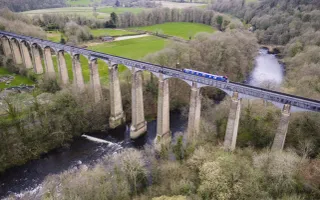Canals that have been impacted
Water levels in some reservoirs are dropping towards minimum levels, with particular pressure on reservoirs feeding the Ashton, Caldon, Grand Union Leicester Line, Grand Union Leeds & Liverpool, Macclesfield, Peak Forest, Rochdale, South Oxford and Trent & Mersey canals. Several lock flights across Birmingham have been closed to preserve water including Brades, Minworth, Rushall and Tame Valley and Wolverhampton.
Some river-fed canals, less impacted to date, are now also increasingly feeling the effects of the continued low rainfall, with lessening flows and environmental legislation limiting the volume that we can feed into the canal network and causing some localised disruption.
While we are doing all we can to keep canals open, the lack of water means the situation can change relatively quickly. We're urging all boaters who are not already doing so to sign up to receive notifications by email or text message about stoppages or restrictions on their local waterways. This is the fastest way to receive up to date information on any local changes.
Our teams on the ground, including many volunteers, are continuing to spend nearly all their time focussing on efforts to conserve and feed all available water – enabling navigation wherever flows allow, and protecting water levels where navigation is stopped to keep boats afloat and wildlife alive. Maintaining water levels where possible is also important to ensure the structural integrity of lock gates, canal retaining walls and the clay-lined bed of many canal stretches.
While the northern canals remain the most severely affected, low water levels are also causing navigation restrictions in some parts of the Midlands and south, with even small pinch points potentially blocking cruising routes. Navigation is still possible in many areas, although the Trust is advising boaters to keep abreast of the latest stoppage notices by signing up for automated alerts via the Trust’s website.
Check our map
A map of the affected areas can be found on the Notices section of the Trust’s website: filter by reason: ‘Low Water Levels’ and select ‘Map View’. There is also advice for boaters affected by navigation restrictions: Drought FAQs.
Boaters will today be sent a short video briefing covering the latest situation, recorded with the Trust’s national hydrology manager Adam Comerford, head of boating & customer service support Matthew Symonds, and operations performance director Daniel Greenhalgh. Visit: Water resources discussion and update 7 Aug 25.
Feeling the strain
Matthew Symonds comments: “Our canal network is feeling the strain after one of the driest springs on record and several heatwaves already this summer.
“On-the-ground teams are carrying out numerous tasks to manage water, including manually operating pumps, sealing up lock gates with ash, putting in stop planks, making ‘quick win’ leak repairs, checking flow gauges, and keeping feeders clear. Volunteer lock keepers are working with boaters to manage boat traffic at lock flights to save as much water as possible. Behind the scenes, our hydrology experts are keeping a day-to-day view of levels and planning for a range of scenarios based on projected demand and rainfall to see how to make best use of the available water.”
Managing our water
Where possible, we're bringing repair works forward to take place during these closures, carried out by different teams so no water management resource is lost. With such a requirement to focus on managing all available water, some tasks, such as routine planned preventative maintenance and keeping up with the paddle pledge, is having to take a necessary temporary back seat.
Matthew continues: “The canal network has a constant demand for water. Whilst boat passage through locks is an obvious use of water, evaporation and transpiration can see canals lose as much as an inch of water on hot summer days. An underlying ‘sweetening flow’ is also always needed to support ecology and avoid canals turning stagnant. We rely on a certain amount of rain throughout the year to keep our reservoirs topped up, but this year we haven’t received anywhere near enough.
“Despite a few heavy downpours recently, we need sustained rain over a number of weeks to recover. We know how disappointing the current restrictions are, and we’re working with hire boat companies who are ensuring that holidays booked this summer continue wherever possible by diverting boats onto routes that are available. As soon as water levels allow, we’ll get the canals back open and remain grateful to boaters for their support and patience. Thank you for helping us by sharing locks where possible, waiting if a lock is set against you, and closing gates and paddles after use.”
The video briefing will be sent to all licence holders for whom the Trust holds an email address. The briefing is hosted on YouTube: Water resources discussion and update 7 Aug 25




